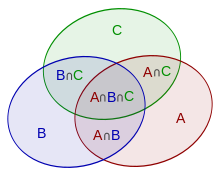In combinatorics (combinatorial mathematics), the inclusion–exclusion principle is a counting technique which generalizes the familiar method of obtaining the number of elements in the union of two finite sets; – From Wikipedia

Example: Set A and B
$|A∪B|=|A|+|B|−|A∩B|$
Set A, B and C
$|A∪B∪C|=|A|+|B|+|C|−|A∩B|−|A∩C|−|B∩C|+|A∩B∩C|$
So we get a normal function:
Given a number N, you are asked to count the number of integers between A and B inclusive which are relatively prime to N.
Two integers are said to be co-prime or relatively prime if they have no common positive divisors other than 1 or, equivalently, if their greatest common divisor is 1. The number 1 is relatively prime to every integer.
The first line on input contains T (0 < T <= 100) the number of test cases, each of the next T lines contains three integers A, B, N where (1 <= A <= B <= 10 15) and (1 <=N <= 10 9).
For each test case, print the number of integers between A and B inclusive which are relatively prime to N. Follow the output format below.
1 | 2 |
1 | Case #1: 5 |
This is just an easy application of the Inclusion-Exclusion Principle. Find the numbers that are not co-prime and cut it of from the given number range.
1 |
|

